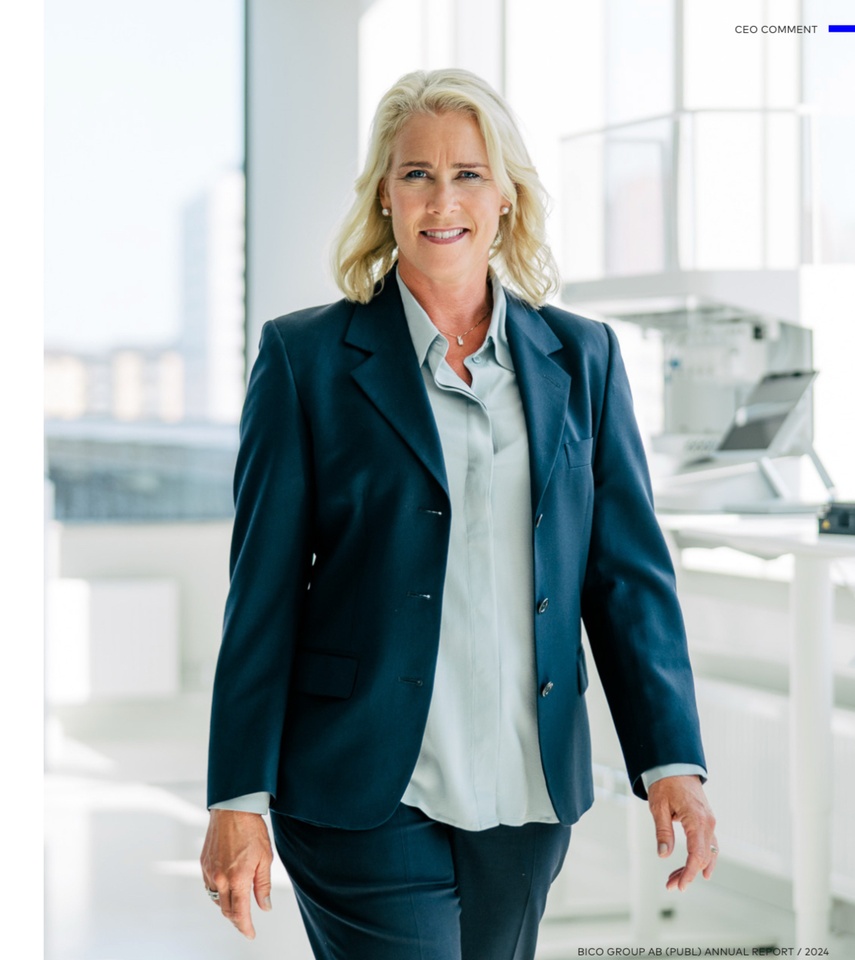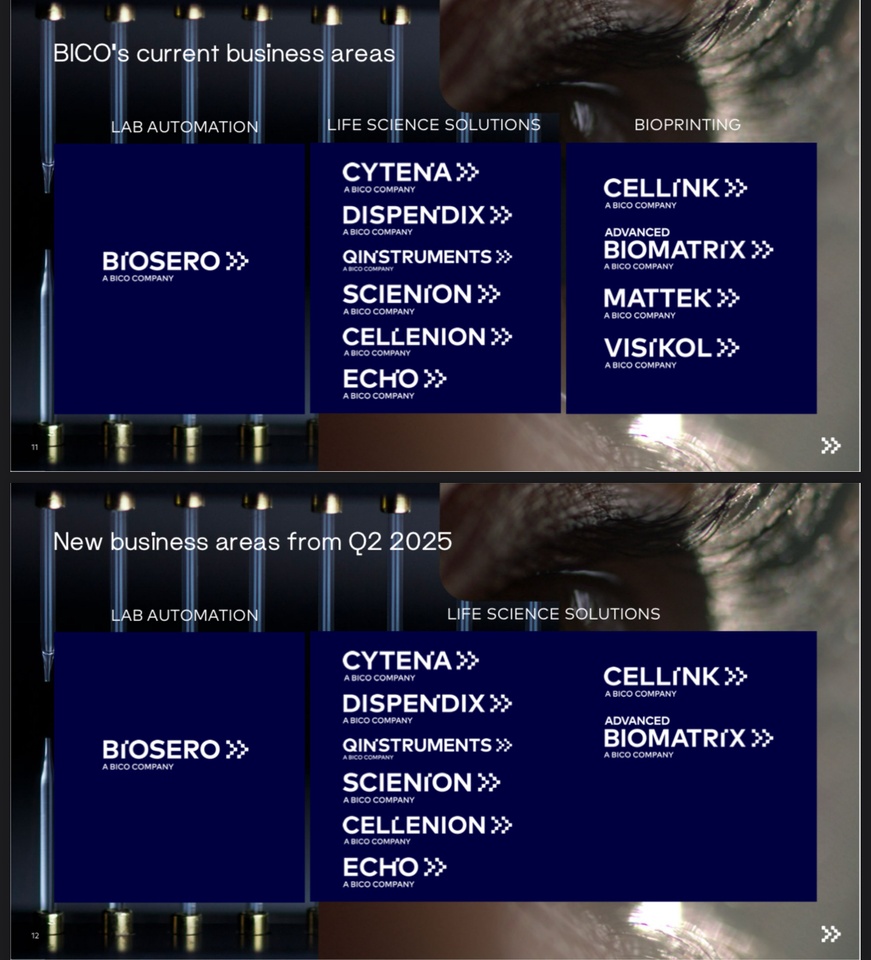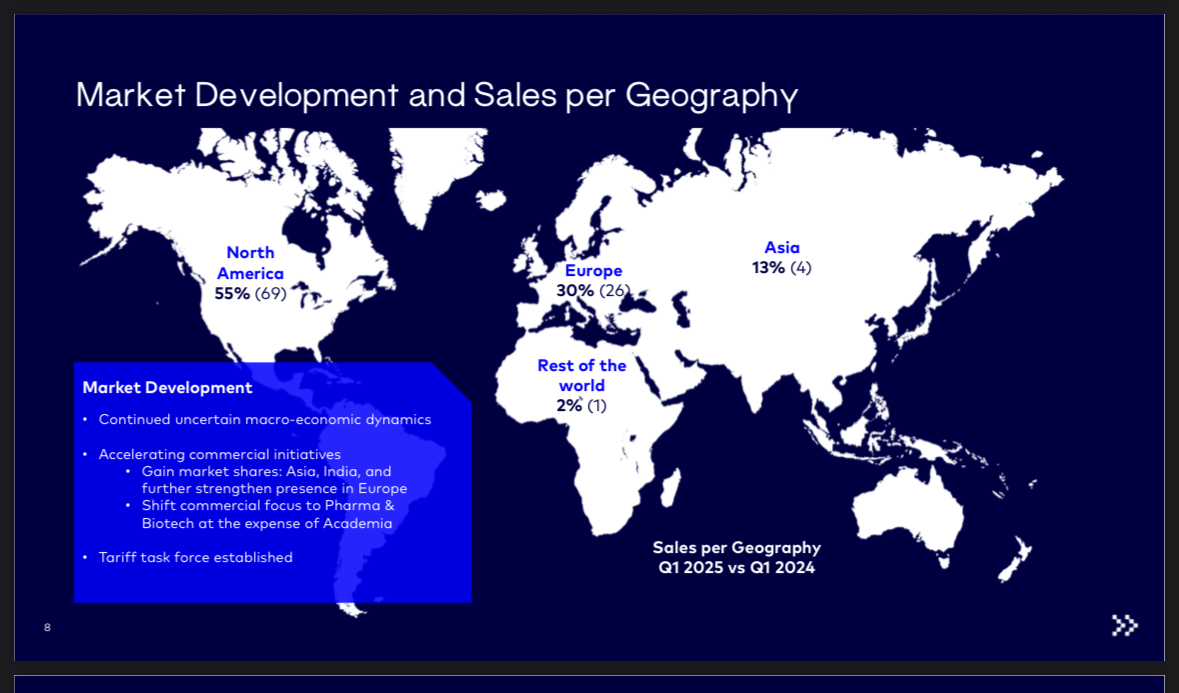What are the gut feelings for
tomorrow?
Postos
86• Divested MatTek & Visikol to Sartorius for $80M, strengthening balance sheet
• Macroeconomic headwinds persist: NIH funding cuts, tariff turbulence delaying CapEx
• Life Science Solutions: mixed results; SCIENION showed healthy growth & profitability
• Lab Automation: high demand but fewer project starts and delays; leadership & process changes underway at Biosero
Q2 2025 (y/y)
• Net sales: SEK 324.2M (−23.4%)
• Organic growth: −17.0%
• Gross margin: 43.9% (↓ from 52.3%)
• Adj. EBITDA: SEK −48.8M (−15.1% margin)
• Net loss: SEK −181.7M (−2.55/share)
H1 2025 (y/y)
• Net sales: SEK 659.0M (−21.8%)
• Organic growth: −19.4%
• Gross margin: 50.4% (↑ from 49.1%)
• Adj. EBITDA: SEK −69.0M (−10.5% margin)
• Net loss: SEK −417.1M (−5.87/share)
• Operating cash flow: SEK +48.4M (vs −68.2M)
Post Q2 Events
• Completed MatTek & Visikol divestment; net proceeds $77.2M
• Repurchased SEK 98M convertible bonds
🧬 BICO
$BICO (+1,84%) has been on my watchlist since my early days on getquin.
In 2021, the company was on everyone's lips, celebrated as the company of the future in bioprinting.
But what followed was a classic hype cycle: the share price rose rapidly, was cheered by quite a few "finfluencers" and then plummeted just as sharply.
Many people got their fingers burnt back then. What remains is the image of an overvalued tech fantasy, fueled by empty promises and loud voices without substance.
And yet: The company has remained. So has the vision, and in recent months a lot seems to have changed structurally.
Today, more than 80 % below its all-time high, the question arises anew:
Is BICO simply an overrated stock market experiment...
... or is the current valuation realistic for the first time and BICO on the way to translating its technological substance into a genuine business model?
Over the past few weeks, I have been taking a closer look at the company's structure, history and current developments, including the latest figures [1] and the earnings call [2] from 29.04.25.
In this article, I share my collected insights, thoughts and assessments for those who also have the company on their watchlist.
As always:
No investment advice. I don't want to contribute to more burnt fingers, but to encourage reflection.
Have fun!
BICO Group AB (formerly CELLINK) is a Swedish life science company founded in 2016.
The original innovation: a biocompatible ink for 3D printing of living cells, a small revolution in research.
Today, BICO stands for a big goal: Bioconvergence.
This means merging biology, technology, software and automation to make research, diagnostics and drug development faster, cheaper and more efficient.
What is the vision and how does BICO make money?
The vision: The laboratory of the future. Automated, networked, efficient with AI, robotics and bioprinting.
This is how BICO earns money today:
Share of Sales 2024:
Excursus
Bioprinting:
BICO was with CELLINK was one of the first suppliers worldwide to offer bioprinters plus matching "bioinks" commercially.
The basic idea:
Bioink and what it is made of:
Bioink is a gel-like substance that is mixed with living cells. It contains, for example:
This matrix keeps the cells alive and makes it possible to print biologically active structures, e.g. tissue samples, tumor models or skin structures.
Is this already being done today or is it all future?
Yes, it is being done, but not clinically.
Bioprinting is currently being used, for example:
What is not yet possible:
Because...
🔮 Future potential: unrealistic or groundbreaking
If bioprinting really breaks through in medicine, we will be talking about one of the biggest breakthroughs of the 21st century:
RealisticFirst functional organs could be available in 10 -20 years clinically relevant, but first in small pilot studies or animal models.
Are there any research results or publications on this?
Yes, BICO (especially CELLINK) is a regular co-author or technology partner in publications.
Especially in areas such as:
Several universities and research institutions use the BIO X printers, including for example MIT and Harvard
Trusted partners:
Digression Conclusion
Bioprinting sounds like science fiction and yes, it is a long way from everyday transplantation. But in research and diagnostics it is real, applicable and in demand.
__________
History in brief From bioink to platform
New CEO since 2024: Maria Forss
Maria Forss brings decades of experience from leading life science companies:
At Vitrolife (2018 - 2023), she led global expansion and M&A projects, including the billion-euro deal with Igenomix. Prior to that (2014 - 2018), she was at Elekta (radiotherapy, oncology) where she was responsible for global marketing and product strategies.
She started her career at AstraZenecawhere she gained international experience in sales, regulatory affairs and market launch. There she learned what makes large pharmaceutical companies tick, particularly in terms of approval, market launch and regulatory navigation
She is an expert in:
The retirement of founder Gatenholm points to a clear change in strategy, away from visionary, growth-driven development and towards cost control, profitability and integration.
In the Earnings Call Q1 2025 Forss emphasizes several times:
"We have implemented a new operational structure, are harmonizing global functions and are focusing on efficiency and selected growth areas."
📊 Q1 2025 in figures and what's really behind it (Caution currency: Swedish krona, 1 SEK ~ 0.10 USD)
Supplement:
Q1 is seasonally weak as many customers (especially in research) do not make large investments at the beginning of the year. At the same time, Q4 was strong, which pulled sales forward.
Comparison of the three previous segments (Q1 2025)
With a view to organic growth:
👩🔬 Life Science Solutions:
🧬 Bioprinting:
🔬Lab Automation:
What do the individual divisions do?
👩🔬 Life Science Solutions:
This is where BICO develops laboratory technologies for diagnostics and cell research, such as devices for high-precision dosing of tiny quantities of liquids, consumables and special analysis platforms.
Examples:
Cancer diagnostics:
Allergy tests:
Genetic testing & DNA analysis:
Point-of-care diagnostics:
🧬 Bioprinting (see excursus above)
🔬 Lab automation
This is about the complete automation of laboratories, e.g. robots that create cell cultures, carry out analyses or coordinate samples. Everything is controlled centrally via the Green Button Go® software from Biosero.
💰 How profitable is BICO currently?
BICO is not yet profitable in the traditional sense, as EBIT (operating result) was clearly negative at SEK -290 million in 2024.
However, the operating cash flow a completely different picture: this was 2024 positive at SEK +259 million, as well as in Q1 2025 at +77 MSEK.
This means that BICO is now earning money in its core business, meaning that liquidity is flowing into the company.
The EBIT is still burdened by high depreciation and amortization on earlier acquisitions, research expenditure and, in some cases, one-off restructuring costs.
Conclusion
up to here:
BICO is not yet "through", but the path to operational profitability is recognizable. The company is heading in the right direction, now it depends on whether it can stabilize its operating base and continue to scale its high-margin business areas.
🤝 Business divisions & restructuring (from Q2 2025)
BICO previously operated in 3 segments:
New from Q2 2025:
Only two divisions, as Bioprinting will be integrated into "Life Science Solutions". Why?
Because CELLINK & Co. are now closely interlinked with diagnostics and consumables. The new setup is intended to increase efficiency, leverage synergies and simplify reporting.
📊 Classification of the figures and why Lab Automation is not growing, even though it is strategically so important
Bioprinting & Life Science Solutions show positive organic growth, while Lab Automationthe third-largest division, shrank massively (-58%).
Automation in particular is one of the main growth drivers in the bioconvergence strategy.
Explanation according to earnings call:
Q1 2024 (PY) was an upward outlier:
Fewer project starts and completions in Q1 2025:
Macro-related reluctance on the part of major customers (pharma):
According to CEO Maria Forss:
"The underlying demand for Lab Automation continues to be strong."
"Project cycles are longer - but demand from pharma remains intact."
Project business is naturally volatile:
BICO's strategic response
Standardization of project packages:
Strengthening project management:
Focus on pharmaceutical customers:
➡️ The decline in sales in Lab Automation looks dramatic, but is primarily due to timing and not a structural problem.
BICO is responding with strategic adjustments to its product portfolio and points to continued strong demand, only with longer lead times.
For investors, this means that the decline is unfavorable but explainable, not alarming
Further statements from the earnings call
CEO Maria Forss:
"Despite a decline in sales, Life Science Solutions and Bioprinting are showing positive development. Our strategy adjustment is taking effect."
Why is bioprinting booming right now?
Excursus in-vitro tissue models:
"In vitro" means: outside the living body, e.g. in a petri dish, on a chip or in a laboratory device.
Tissue models are replicated biological structures that resemble real human (or animal) tissue.
Example:
A skin tissue printed with cells that is used for cosmetic or drug tests, without animal testing.
What's the point?
In vitro tissue models are an ethically and scientifically attractive alternative to animal testing and BICO supplies the printing technology for this, among other things.
Is BICO a unique company in bioprinting?
No, but one of the pioneers with a broad portfolio.
There are competitors such as Allevi, Aspect Biosystems and Organovo, but BICO combines hardware, software and services under one roof - a strategic advantage.
Where does the market currently stand and what does the future look like?
Possible future scenarios
1 . BICO becomes a global playerBICO continues to grow, automates laboratories worldwide
2 . BICO becomes a takeover candidate: Groups such as Sartorius $SRT (+0,74%) , Danaher $DHR (+2,08%) or Thermo Fisher $TMO (+0,27%) could strike
3 . BICO remains niche leader: Focused on profitable segments with high innovation density
Risks & critical voices
The topic of the convertible bond has made me sit up and take notice again; here are some more deep dives:
What's the deal with BICO's convertible bonds until 2026?
Convertible bonds are a kind of hybrid between a bond and a share. They work like this:
At the end of the term (March 2026), investors receive either:
The whole thing is attractive for companies because they:
What this means in concrete terms:
Why is this an issue for investors
1 . Repayment or dilution:
If BICO cannot repay the amount, new shares must be issued, this is called dilution because your stake in the company decreases.
2 . Cash flow burden:
If BICO wants to repay the amount from its own resources, it needs a lot of liquidity, which can slow down other investments.
3 . Refinancing risk:
If the market is weak in 2025/26, refinancing could become expensive or not possible at all.
What is the current situation?
Positive:
Statement on financing / repayment
CFO Jacob Thornberg said:
"The closing of the divestment of MatTek and Visikol for USD 80 million is expected to take place during Q2 2025 [...]
The proceeds from the transaction will be used to resolve the outstanding convertible bond, which matures in March 2026."
Translated:
The entire proceeds from the sale of MatTek & Visikol to Sartorius (USD 80 million) are earmarked for the repayment of the convertible bond.
Management's assessment of the financial position:
"We expect to move into a net cash position during Q2 2025."
This means:
Assessment: How credible is this?
Positive:
-> Repayment can be financed if no new setback occurs
But:
➡️ Management is actively pursuing the plan to redeem the convertible bond in full before maturity in 2026 without dilution.
The sale of MatTek & Visikol has freed up concrete capital for this.
The direction is right, but BICO remains a risky stock with operational debt.
More on profitability:
In the Q1 2025 Earnings Call BICO's management did not give a specific date for break-even or profitability
... which is typical for growth companies with highly volatile project business.
What was said instead?
On profitability in Q1 itself:
EBITDA was negative (SEK -12m), but:
"Adjusted EBITDA was in line with Q1 2024 due to the positive development in Life Science Solutions and Bioprinting."
-> Improvement due to mix effects and operational measures
Long-term statements?
No specific annual figure or guidance on profitability. But:
"We have launched a new operating model [...] to achieve improved commercial as well as operational efficiencies."
"We will continue to optimize our cost base and drive efficiency through integration."
Interpretation:
The focus is on the short term:
Butunfortunately no clear words like: "We plan to be profitable in 2025 or 2026." 😬
Will BICO be the company that prints organs, or is it more likely to be taken over?
Technologically, BICO is very well positioned today when it comes to bioprinting infrastructure:
ButPrinting fully functional organs for clinical applications is a gigantic leap, not only technologically, but also in regulatory, medical and logistical terms. This is what is needed:
These are competencies that are more common in corporations like Johnson & Johnson $JJ, Medtronic $MDT (-1,94%) , GE Healthcare $GEHC (-0,16%)
, Siemens Healthineers $SHL (-0,39%) or Thermo Fisher $TMO not a smaller platform provider like BICO.
Which is more likely?
1 . BICO remains the "toolmaker" of the bioprinting world:
Just like ASML for semiconductors or Illumina for genomics, but without building drugs/organs itself.
2 . BICO will be taken over when the topic becomes clinically concrete:
For example, when the first major organ projects enter the clinical phase, it is likely that a giant will strike to secure access to the technology.
3 . BICO remains an enabler, but not the final provider of clinical bioprinted organs
When organs are actually printed, will BICO become the global market leader?
🏷️ Unlikely.
➡️ More realistic is that BICO becomes one of the key technology suppliers or is taken over by one of the big players beforehand.
This can still be highly attractive for investors. After all, whoever supplies technology will be needed, regardless of who ends up operating on the patient.
Should we now focus on BICO or rather on a large corporation with bioprinting potential? 🤔
1 . Buy BICO for speculative returns
Pros:
Contra:
2 . Alternatively: back a large corporation for more stability
Which big players have the potential to drive bioprinting forward (or take over BICO)?
Sartorius
-> Best-case candidate for takeover or joint venture
Thermo Fisher Scientific
-> Comes into play when bioprinting is more closely integrated into pharmaceutical production
Danaher
-> Could strike when the market matures, but rather late and strategically
3D Systems / Stratasys
-> Riskier than classic medtechs, but a direct bioprinting play
Personal classification: substance or science fiction on credit?
What makes more strategic sense? Which investment is "the right one"?
OR
Combination strategy:
I invest a small position in BICO as a "moonshot", combine this with a solid underlying position in Sartorius or Thermo Fisher and cover the technology and protect the capital if BICO fails.
The two underlying positions mentioned can of course also represent a global ETF.
My personal assessment of BICO currently fluctuates between cautious optimism and realistic doubt.
On the one hand, I see a clear technological lead and a strategy that, unlike a year or two ago, now appears more well thought-out and focused. Partnerships with established players such as Sartorius also give me the feeling that BICO is not operating alone in a vacuum.
On the other hand, the operational foundation is still shaky. Profitability has not been achieved and the issue of the 2026 convertible bond hangs over the company.
Without sufficient cash flow or fresh capital, the ambitious vision could stumble, and despite all the enthusiasm for bioprinting and automation, we should always be aware of this.
BICO is not a stock for quiet nights, but for visionaries with patience it may be a ticket to the future of medicine.
I am currently waiting for an entry opportunity with a good feeling. The goal could be a portfolio share of up to approx. 3-4%, which then remains in place and is reduced in the future through portfolio growth without selling.
Thanks for reading! 🤝
______________
Sources:
[1] https://storage.mfn.se/5a3030c0-d13b-4177-80d0-94da59c7302d/bico-q1-2025-eng.pdf
[2] https://bico.events.inderes.com/q1-report-2025/register
/ https://web.quartr.com/link/companies/4484/events/247443/transcript?targetTime=0.0
More:
https://www.sartorius.com/en/company/investor-relations




BICO Group AB has bought back convertible bonds + Intel in talks about the sale of Altera + Jefferies raises STMicro to 'Buy' with target up to 34 euros + AI and robotics hopes at Meta remain in focus + Exasol with preliminary consolidated figures for 2024
BICO Group AB $BICO (+1,84%)has repurchased convertible bonds worth SEK 276 million
Intel $INTC (-0,48%)in discussions regarding the sale of Altera
(Financial Times)
Jefferies raises STMicro $STMPA (+0,17%)to 'Buy' - target up to 34 euros
AI and robot hopes at Meta $META (+0,28%)remain in focus
Exasol $EXL (+1,99%)with preliminary Group figures for 2024
Wednesday: Stock market dates, economic data, quarterly figures
Economic data
08:00 DE: Manufacturing orders on hand and order backlog December
08:00 UK: Consumer prices January
08:00 UK: Producer prices January
10:00 EU: ECB, Eurozone Current Account December
10:00 CH: WTO, General Council Meeting (since 18.02.)
14:30 US: Housing Starts/Permits January
19:00 DE: CDU leader Merz, CDU election campaign event, Vechta
20:00 US: Fed, minutes of the FOMC meeting on January 28/29

26.11.2024
BICO with poor quarterly figures + Trump's tariff threats weigh on stock markets + Tui wants to further reduce debt and invest
BICO Group
$BICO (+1,84%) delivers very poor quarterly figures
On his first day in office, US President-elect Donald Trump intends to impose high import tariffs on all goods from Mexico and Canada as well as additional tariffs on goods from China. This will be one of his first executive orders on January 20, Trump explained on the Truth Social platform, which he co-founded.
Tariffs of 25 percent are to apply to goods from Mexico and Canada. The US President-elect justified this with immigrants who bring crime and drugs across these two borders into the USA. Until this stops, the tariffs should remain in force. Both Canada and Mexico have the power to solve the problem. "We hereby call on them to use their power, and until they do, it's time for them to pay a very high price," Trump explained. Additional tariffs of ten percent are to apply to goods from China. Trump also justified this with the fact that drugs such as the deadly fentanyl were entering the USA from the country. Although China has announced that it will take action against this, it has not done so. US President Joe Biden, who is still in office, met China's head of state Xi Jinping on the sidelines of the Asia-Pacific Economic Community (Apec) summit in the Peruvian capital Lima just over a week ago. Xi had assured Biden there that he also wanted to work together with the future US administration under Trump.
With the share price of TUI $TUI1 (-2,43%) Sebastian Ebel is not satisfied. However, the Tui CEO will not be boosting the share price with a dividend payment for the time being; his focus in the use of free cash flow is on investments and debt reduction. "Our goal is to reduce our net leverage to well below 1x. When we present our figures for the financial year in December, you will see that we have already taken a big step towards this goal," Ebel told the Börsen-Zeitung. The rating has not yet returned to pre-crisis levels. "These components are the basis for formulating a sustainable dividend policy, which is an entrepreneurial decision that we will make in due course," said Ebel. (Börsen-Zeitung)
Tuesday: Stock market dates, economic data, quarterly figures
ex-dividend of individual stocks
Johnson & Johnson USD 1.24
Quarterly figures / company dates USA / Asia
13:00 Analog Devices quarterly figures
13:30 Abercrombie & Fitch quarterly figures
22:30 HP Inc quarterly figures
No time specified: Dell | Best Buy | Autodesk | Macy's Quarterly figures
Quarterly figures / Company dates Europe
07:00 Siemens Healthineers detailed annual results and annual report
Untimed: Stratec - Analyst conference on the occasion of the German Equity Forum
Economic data

Principais criadores desta semana